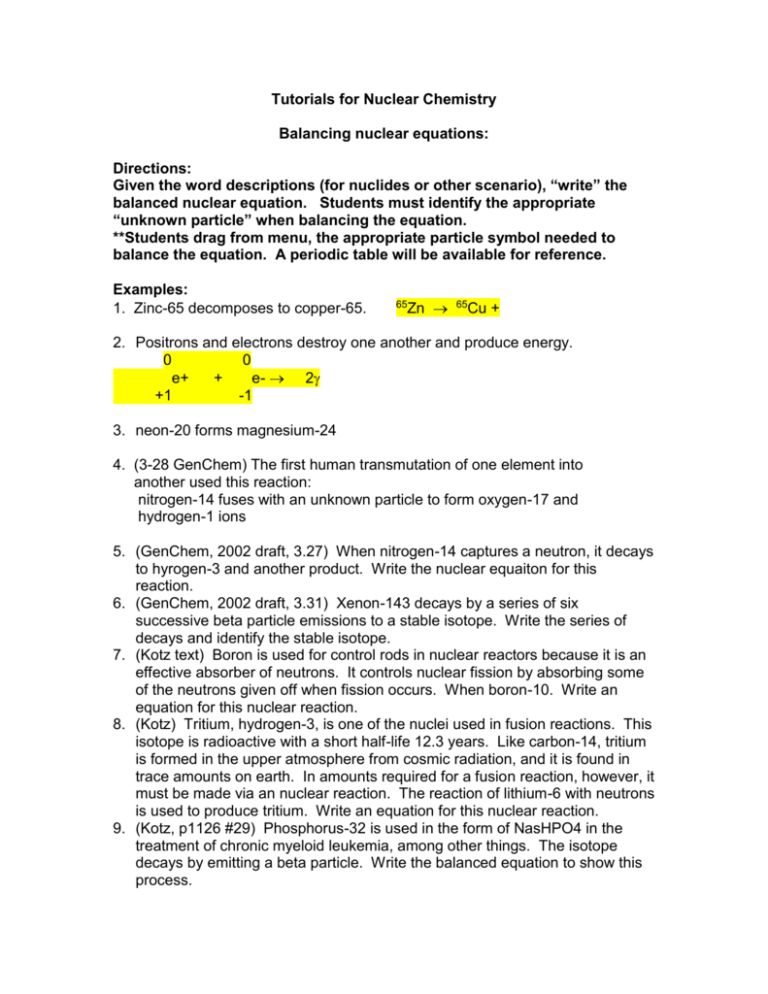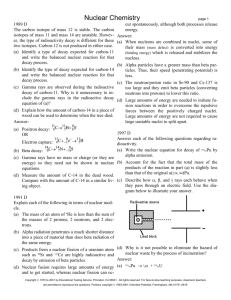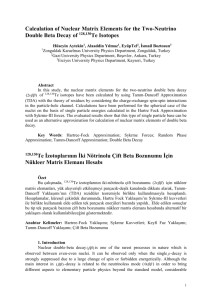Tutorials for nuclear chemistry
advertisement

Tutorials for Nuclear Chemistry Balancing nuclear equations: Directions: Given the word descriptions (for nuclides or other scenario), “write” the balanced nuclear equation. Students must identify the appropriate “unknown particle” when balancing the equation. **Students drag from menu, the appropriate particle symbol needed to balance the equation. A periodic table will be available for reference. Examples: 1. Zinc-65 decomposes to copper-65. 65Zn 65Cu + 2. Positrons and electrons destroy one another and produce energy. 0 0 e+ + e- 2 +1 -1 3. neon-20 forms magnesium-24 4. (3-28 GenChem) The first human transmutation of one element into another used this reaction: nitrogen-14 fuses with an unknown particle to form oxygen-17 and hydrogen-1 ions 5. (GenChem, 2002 draft, 3.27) When nitrogen-14 captures a neutron, it decays to hyrogen-3 and another product. Write the nuclear equaiton for this reaction. 6. (GenChem, 2002 draft, 3.31) Xenon-143 decays by a series of six successive beta particle emissions to a stable isotope. Write the series of decays and identify the stable isotope. 7. (Kotz text) Boron is used for control rods in nuclear reactors because it is an effective absorber of neutrons. It controls nuclear fission by absorbing some of the neutrons given off when fission occurs. When boron-10. Write an equation for this nuclear reaction. 8. (Kotz) Tritium, hydrogen-3, is one of the nuclei used in fusion reactions. This isotope is radioactive with a short half-life 12.3 years. Like carbon-14, tritium is formed in the upper atmosphere from cosmic radiation, and it is found in trace amounts on earth. In amounts required for a fusion reaction, however, it must be made via an nuclear reaction. The reaction of lithium-6 with neutrons is used to produce tritium. Write an equation for this nuclear reaction. 9. (Kotz, p1126 #29) Phosphorus-32 is used in the form of NasHPO4 in the treatment of chronic myeloid leukemia, among other things. The isotope decays by emitting a beta particle. Write the balanced equation to show this process. 10. Predict the kind of decay expected and write the nuclear equation for each of the following radioactive nuclides. (Zone of stability needed) a. Uranium-234 = atomic number 92… alpha b. arsenic-77 = … above zone of stability … beta decay c. aluminum-26 = mass # smaller than the atomic mass of the element..too many protons for stability…expect positron emission and electron capture are possible. Fill in the missing emission type to properly balance the nuclear reactions. Source: GenChem, Alpha Version. Problem 3.17 Example: Fill in the proper emission type that describes how the fusion of two Carbon-12 (each with a +6 charge) leads to the formation of the following: Sodium-23 (11+ charge) Magnesium-23 (12+ charge) Using images or illustrations, represent certain types of nuclear reactions. Explain (pick an appropriate explanation that is an option in the menu. Examples: (GenChem, 2002 draft 3.40, 3.43) carbon-12 reaction with helium-4 to form oxygen-16 Pick from isotopic illustration and drag to balance nuclear equations. Animation examples from GenChem website3.5 – 2 View animations of nuclear fusion and fission and answer questions. Decay Series Nuclear reactions produce radioactive products that undergo a series of reactions until a stable nuclide is produced. Solve the decay series described below. 1. The first four steps of the decay series of Uranium-238 involves the following series of events. Determine the missing links to compete the decay series. Uranium-238 forms thorium-234, which decomposes producing a beta particle. The next reaction produces uranium-234 with the fourth step producing thorium230 and an alpha particle. 2. (Kotz p1095) Six alpha and 4 beta particles are emitted in the thorium-232 radioactive decay series. What is the final product of the series? 3. (Kotz) The first three steps in the thorium-232 decay series are alph, beta and beta emissions, respectively. Write a nuclear equation for each step. 4.







![The Politics of Protest [week 3]](http://s2.studylib.net/store/data/005229111_1-9491ac8e8d24cc184a2c9020ba192c97-300x300.png)


